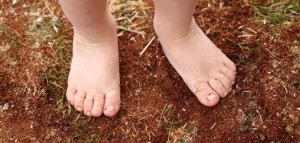Feet For Occupational Therapists
By: Dr. Joni Redlich, DPT, PCS

As a physical therapist working with children I have worked very closely with pediatric occupational therapists in a variety of settings. There are areas of overlap that both OTs and PTs address, and also areas that we can consult with each other to maximize the child’s outcomes.
PTs have a strong knowledge base in movement systems, particularly the musculoskeletal system for motor function. OTs have a strong foundation in maximizing a child’s overall abilities to function in daily life. One problem area that OTs and PTs will both often address is balance. If balance and gross motor skills are impaired, it is important to look at postural alignment from head to toe. An area that OTs have less training in observing and assessing in the alignment and function of the feet. Feet serve as the basis for balance and gross motor skills in standing. If alignment is not present, it will be difficult to improve postural control higher up.
It is beneficial for OTs to have knowledge as to what feet should look like, common deviations, and when to refer to PT to address the problem via orthotic prescription or other intervention.
The most common problem that an OT may observe in the child is foot pronation. This is commonly seen in children with low tone, including diagnoses such as autism spectrum disorders, dyspraxia and genetic disorders. Have the child stand barefoot facing away from you. Look at the alignment from the leg to the heel. This should make a straight line. If the heel is turning out and the arch is collapsed, then the foot is pronated. Consult with a PT to determine whether intervention is warranted. There are times when its appropriate to intervene and other situations when this is a normal deviation that is not affecting function.
Toe-walking is another common foot-related problem that an OT encounters. This is seen commonly in children with autism spectrum disorders, but is also present in CP, muscular dystrophy, and idiopathic toe-walking. Children who persistently walk on their toes will develop tightness in their calves over time. This can lead to the inability to stand flat without the foot turning out in compensation. Consult with a PT to address these flexibility concerns and intervention options.
The above are two common foot deviations that may be seen in children that are receiving OT, but not PT services. It is important for OTs to know what to screen for to make referrals to PT when appropriate. So take those shoes and socks off and take a look at how the child’s feet may be affecting their balance and gross motor skills. Then bring in a team member when necessary to help children meet their goals as quickly as possible.
Featured Author: Dr. Joni Redlich, DPT
Dr. Redlich is a Mom, Wife and Pediatric Physical Therapist Specializing in Children with Developmental Disabilities. She received a B.A in Psychology from Emory University and her M.S in Physical Therapy and DPT from Arcadia University (formerly Beaver College). Joni received her board certification as a Pediatric Clinical Specialist in 2011
Please visit her website at Kid PT
PediaStaff is Hiring!
All JobsPediaStaff hires pediatric and school-based professionals nationwide for contract assignments of 2 to 12 months. We also help clinics, hospitals, schools, and home health agencies to find and hire these professionals directly. We work with Speech-Language Pathologists, Occupational and Physical Therapists, School Psychologists, and others in pediatric therapy and education.
